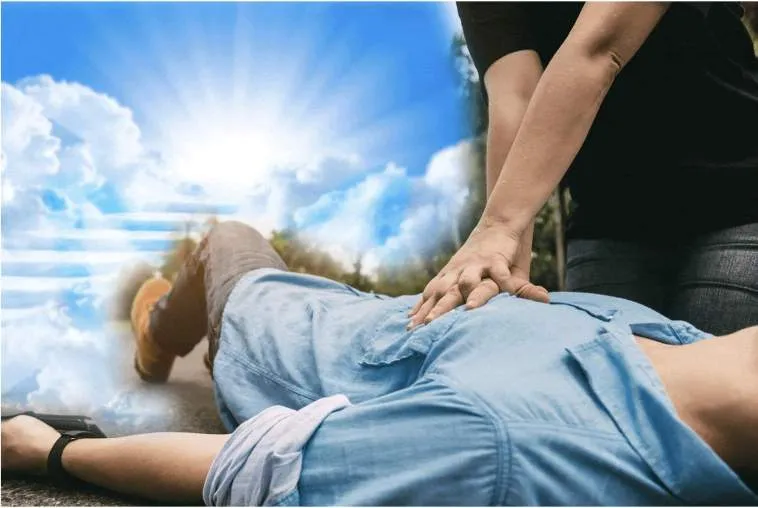(New York Post) It’s not a deathbed myth: Our lives really do flash before our eyes when we die, according to a new report from the NYU Grossman School of Medicine.
“I remember seeing my dad,” said one patient after flatlining.
“I caught glimpses of my life and felt pride, love, joy and sadness, all pouring into me,” recalled another after being pulled back from the brink.
“I do remember a being of light … standing near me. It was looming over me like a great tower of strength, yet radiating only warmth and love,” a third survivor shared.
These and many other haunting recollections were described by cardiac arrest patients who underwent cardiopulmonary resuscitation as they hovered on death’s doorstep.
Typically, doctors have assumed there is little to no brain activity after about 10 minutes of cardiac arrest, when the heart stops beating, depriving the brain of oxygen.
However, the new research from NYU turns that misconception on its head.
“There are signs of normal and near normal brain activity found up to an hour into resuscitation,” Dr. Sam Parnia, an associate professor of medicine at NYU Langone Health, told The Post in a wide-ranging interview.
“We were not only able to show the markers of lucid consciousness — we were also able to show that these experiences are unique and universal. They’re different from dreams, illusions and delusions.”
Parnia is the lead author of a study published this week in the journal Resuscitation that studied brain activity and awareness among 53 patients who survived cardiac arrest at 25 hospitals, mostly in the US and UK.

The researchers were able to show that the brain is surprisingly more durable than most doctors had previously believed.
“Our brain is very robust” and “is more resilient to oxygen deprivation” than expected, said Parnia, adding that the organ “can restore itself and have markers of normal brain activity.”
Of the 53 surviving patients in the study, almost 40% reported having memories or conscious thoughts. Patients in the study asked that their identities not be revealed for privacy reasons.
The patients also had spikes in the gamma, delta, theta, alpha and beta brain waves associated with higher mental function, as recorded by an electroencephalogram, a technology that records brain activity with electrodes.
 People who flatlined for up to an hour often experienced “lucid dying,” according to study author Dr. Sam Parnia.Getty Images/ABSODELS RF
People who flatlined for up to an hour often experienced “lucid dying,” according to study author Dr. Sam Parnia.Getty Images/ABSODELS RF
“There is a narrative arc in people who are having a near-death experience,” Parnia said of the common themes that survivors recalled. “Their consciousness becomes heightened, more vivid and more sharp.”
One of the most common shared experiences among people who have been revived following cardiac arrest is a 360-degree awareness of the space around them.

“In death, they have a perception that they are separate from their body,” Parnia said, “and then they can move around. But they’re in that [hospital] room and they’re gathering information. They felt that they were fully conscious.”
In that state of awareness, they’re often observing doctors and nurses working to save their lives, but their observation is completely placid and free of fear or distress.
 Cardiac arrest patients revived after near-death experiences often report eerily similar thoughts and feelings. “I had no fear about where I was going and what to expect when I arrived there,” one survivor said. “Then I felt warmth … Then there was the desire to be home.”NY Post
Cardiac arrest patients revived after near-death experiences often report eerily similar thoughts and feelings. “I had no fear about where I was going and what to expect when I arrived there,” one survivor said. “Then I felt warmth … Then there was the desire to be home.”NY Post
 Resuscitation survival rates are frustratingly low, in part because technologies haven’t advanced much since CPR was invented in 1960. “I could feel someone doing something on my chest. I couldn’t feel the actual compressions, but I could feel someone rubbing quite hard,” one revived patient told NYU researchers. “It was quite painful.”
Resuscitation survival rates are frustratingly low, in part because technologies haven’t advanced much since CPR was invented in 1960. “I could feel someone doing something on my chest. I couldn’t feel the actual compressions, but I could feel someone rubbing quite hard,” one revived patient told NYU researchers. “It was quite painful.”
sopiangraphics – stock.adobe.com
And, yes, many people actually do see their lives pass before their eyes, much like in stories from folklore and popular media.
“Somehow in death their entire life comes to the fore,” said Parnia. “It’s a deep, purposeful and meaningful reevaluation of their lives.”

This review of their lives isn’t in any particular order, Parnia said, but more of a dive into morality and ethics. “It’s not a chronology. It’s a purposeful reevaluation of the things that we strive for in life, like a promotion at work.
“What becomes a primary reality is how we treat other people,” added Parnia, who is also director of critical care and resuscitation research at NYU Langone Health. “It’s not random flashbacks. There’s so much more.”
Another common theme is the sense of arriving at a place that feels utterly familiar: home. “Somewhere that they feel they recognize, and are going back to. They continue on the rest of this journey to a place that they feel is like home,” Parnia said.
“What’s interesting is that this is universal, in the US and in other countries.”
Science doesn’t yet fully understand how or why these common experiences occur, but Parnia believes the brain’s normal operating focus, which gets us through the day, becomes relaxed and “disinhibited” during near-death experiences.







